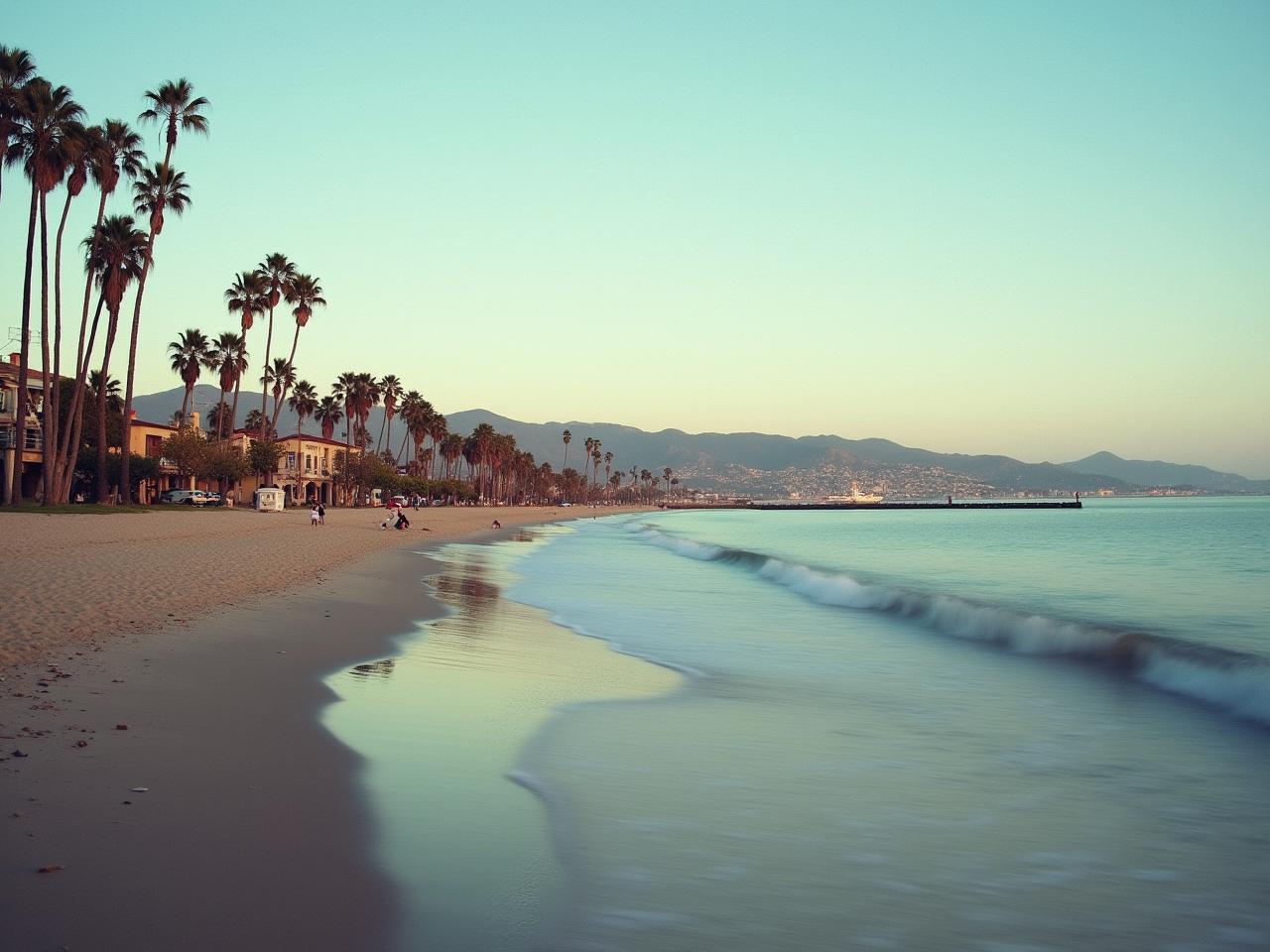Wednesday, July 23, 2025
Santa Barbara, once a vibrant hub for international and domestic tourists, is now facing a significant decline in visitor numbers, joining cities like Los Angeles, San Francisco, Anaheim, San Diego, San Jose, and Ontario in recording a massive tourism slump for the US industry. In recent months, the coastal city has seen a drop in both international and domestic travelers, with international arrivals down due to rising political tensions, economic uncertainty, and shifting global travel preferences.
For American and Canadian tourists, this downturn may signal changes in future travel patterns, as other destinations emerge as more appealing alternatives. Santa Barbara, renowned for its stunning landscapes, historic landmarks, and world-class wineries, is now grappling with the challenges of adjusting to a new travel reality. As we examine the factors driving this slump, it’s essential to understand how local tourism is adapting and what it means for future visitors looking to explore the city’s charm.
Advertisement
Advertisement
California, one of the most sought-after destinations for global travelers, is witnessing a disturbing trend: a significant drop in international tourism. As of 2025, the state has seen an alarming decline in the number of visitors coming from abroad, particularly those from neighboring countries like Canada and Mexico. This decline comes at a time when the state is known for its diverse attractions, from its stunning coastline and world-class wine regions to its iconic landmarks like Old Mission Santa Barbara and Los Angeles.
The Decline in International Visitors
The numbers don’t lie—California has seen a notable drop in visitors from key international markets. Visitor numbers from Canada and Mexico have been hit hardest, with air arrivals from Canada down by 15.5% and those from Mexico falling by 24.2%. This is a worrying sign for the state’s tourism sector, which has long depended on these neighboring countries for a significant portion of its international traffic.
The travel patterns are changing, and this shift isn’t just about fewer people traveling; it’s about the changing motivations behind travel. International tourists are increasingly bypassing California in favor of other destinations. According to Visit California’s latest forecast, the state is on track to lose around 6 million international visitors in 2025 alone, contributing to an overall 9.2% drop in international tourism for the year.
The Impact of Political and Economic Factors
One of the key reasons behind the decline in California tourism in 2025 is the global political climate. Over the past few years, political decisions in the U.S. have contributed to a perception of the country as less welcoming to international visitors. Stricter immigration policies, rising tariffs, and the perception of an unfriendly environment for foreigners have resulted in fewer international tourists visiting major U.S. cities, including those in California.
Los Angeles, San Francisco, and other cities that traditionally attracted significant international traffic have all reported declining visitor numbers from key markets like Europe, Asia, and Latin America. According to data from Los Angeles World Airports, international bookings for Los Angeles have decreased by 3.5% in early 2025 compared to the previous year. This trend is not isolated; it reflects broader global shifts, with San Francisco also reporting a 5% decline in international visitation for the same period.
Economic uncertainty has also played a role in deterring international travelers. The strengthening of the U.S. dollar has made travel to California more expensive for visitors from countries with weaker currencies, such as those in Latin America and Europe. The rising cost of airfares and accommodation, combined with an uncertain political and economic environment, has caused many potential visitors to reconsider their travel plans.
Economic Pressures on the Tourism Industry
California’s tourism sector is also facing mounting economic pressures that have led to a decrease in spending. Rising inflation and cost-of-living increases in California have made it more difficult for tourists to justify the expense of traveling to the state. Many international visitors who would have traditionally visited California are opting for other destinations that offer more affordable travel options.
According to the Santa Monica Travel & Tourism Board, international travelers are staying away due to the cost of U.S. travel and the perception that it no longer offers the same value as other countries. Meanwhile, domestic travelers are also feeling the pinch, with many rethinking their travel plans in light of the economic landscape.
Regional Variations: Impact on Major California Cities
While the tourism downturn is being felt statewide, the impact varies across different cities, with some cities experiencing a more pronounced decline than others.
Los Angeles: Tourism Revenue Drops Amid Policy and Economic Struggles
Los Angeles, one of the world’s leading tourist destinations, has seen a drop in international tourist arrivals. With its iconic attractions such as Hollywood, Venice Beach, and Santa Monica, Los Angeles has historically drawn millions of visitors annually. However, as international travelers become more cautious, L.A.’s tourism industry is experiencing a 3.5% decrease in visitors, according to recent data.
The city’s transient occupancy tax revenue has also seen a decline, reflecting the reduced number of tourists booking hotels and other accommodations. Local tourism businesses are feeling the effects, as fewer international tourists are spending money on activities, dining, and shopping. Moreover, the LA Convention Center has also seen lower attendance at major international events and trade shows, which were once a significant source of revenue for the city.
San Francisco: Cultural and Economic Shifts Contribute to Decline
San Francisco has long been a popular destination for international visitors, thanks to its cultural landmarks, vibrant food scene, and stunning architecture. However, in 2025, international visitor numbers dropped by 5%, which is impacting tourism-related businesses. The Golden Gate Bridge, Alcatraz Island, and other historic sites have seen fewer foreign tourists this year, contributing to a noticeable shift in the city’s tourism landscape.
Economic factors such as hotel price hikes, combined with the political climate, have made San Francisco less attractive to international tourists. Additionally, reports from the San Francisco Travel Association indicate that business travel to the city has also seen a decline, with more companies cutting back on meetings and conferences in response to the economic uncertainty and the political environment.
Anaheim: Local Growth Amidst International Setbacks
In Anaheim, home to the world-famous Disneyland Resort, tourism has remained relatively steady. While international tourism to Anaheim has declined slightly, domestic tourism has been able to make up for the shortfall. Anaheim saw an increase in the number of domestic visitors in 2024 and 2025, with many families traveling to Disneyland and other attractions. However, the overall transient occupancy tax collections were down by 1.2%, which highlights that international visitors remain a key component of the tourism economy.
The city is also benefiting from new developments, including additional hotel space and more entertainment options. These projects are expected to boost visitation in the long term, especially with the upcoming 2028 Summer Olympics.
San Diego: Economic Concerns and Changing Visitor Preferences
San Diego, known for its beautiful beaches, Balboa Park, and family-friendly activities, has experienced a decline in tourism. While the city has always attracted a healthy mix of international and domestic visitors, 2025 has seen a projected decrease in international tourists. This downturn is attributed to economic uncertainty, rising travel costs, and changes in the global travel environment.
Additionally, many travelers are shifting their focus to other U.S. destinations, such as Florida, that are perceived to be more affordable and accessible. According to San Diego Tourism Marketing District, the city has faced challenges in growing its visitor numbers, especially among international tourists.
San Jose and Ontario: Stable Domestic Growth, but International Decline
San Jose and Ontario have seen more stable domestic tourism growth compared to their larger counterparts like Los Angeles and San Francisco. However, both cities have faced declining international visitation. According to data from San Jose Convention and Visitors Bureau, the city’s international arrivals were down by 2.4% in 2025. Ontario, a city largely driven by domestic tourism and its proximity to Ontario International Airport, has also seen a slight decrease in international visitors, although domestic tourism has remained stable.
Both cities are investing in infrastructure to boost their domestic tourism market, with more focus on attracting business travelers and regional visitors.
Steps to Overcome the Tourism Slump
To address the decline in international tourism, California cities will need to adapt by targeting new international markets, enhancing their digital marketing efforts, and focusing on improving the visitor experience. Many cities are also working on initiatives to encourage year-round travel, such as off-peak season promotions, new attractions, and events that cater to different cultural demographics.
Furthermore, reducing barriers for international travelers, including easing visa requirements and creating travel-friendly policies, could play a crucial role in reversing the downward trend.
A Complex Path Forward for California’s Tourism Industry
While California’s tourism sector faces significant challenges in 2025, its iconic cities remain some of the most desirable destinations globally. The decline in international tourism is a multifaceted issue, influenced by political, economic, and social factors. However, with the right strategies and initiatives, California’s tourism industry can recover and adapt to the changing global landscape, ensuring its position as a top travel destination for years to come.
Global Perceptions and Political Tensions
So, what’s behind this decline? The political climate plays a crucial role in shaping international perceptions of the U.S. Over the past several years, policies such as stricter visa regulations, tariffs, and general rhetoric coming from the U.S. administration have fostered a sense of unease among potential visitors. For many, the current political environment seems less welcoming than in years past, which has led to hesitancy in booking international travel to the U.S.
The U.S. travel ban, increasing immigration restrictions, and rising trade tensions have made it harder and more expensive for many international visitors to travel to California. Even the perception of the U.S. as a destination for leisure and cultural enrichment is shifting. As a result, political concerns have been playing a bigger role in decision-making processes for international travelers, particularly from regions like Europe, Asia, and Latin America.
Economic Factors at Play
Another major factor affecting California’s tourism decline is economic pressures both in the U.S. and abroad. With the U.S. dollar strengthening, California has become a more expensive destination for travelers from countries with weaker currencies. The cost of travel has risen, with inflationary pressures pushing up airfare prices and accommodation rates. For many international tourists, these added costs make other destinations more attractive and accessible.
At the same time, tariffs and trade wars have contributed to a sense of economic uncertainty, particularly among tourists from trade-dependent regions. This uncertainty has led many to rethink their travel plans, and some are opting to visit countries where the financial barrier is lower or where the political climate feels more stable.
Local Tourism Remains Strong, But Will It Be Enough?
Interestingly, while international tourism has taken a hit, local tourism has remained relatively robust. Many residents of California continue to visit local attractions, and domestic travel has not experienced the same downturn. In cities like Santa Barbara, Los Angeles, and San Francisco, domestic visitors have stepped up to fill the gap left by the decline in international travelers.
However, local tourism cannot entirely replace the lost revenue from international travelers. The financial impact of fewer international visitors is felt across a wide range of industries, from hospitality and transportation to retail and entertainment. Without the spending power of international tourists, local businesses are seeing reduced revenue and fewer job opportunities in sectors that rely heavily on tourism.
Broader Implications for the State’s Economy
The economic impact of declining international tourism in California is far-reaching. The $12.5 billion shortfall in visitor spending is just the beginning. California’s tourism industry supports over 1 million jobs, many of which are tied directly to the influx of international visitors. Fewer international tourists mean fewer job opportunities, lower wages, and decreased economic activity in tourism-dependent regions.
The state government is already taking note of these challenges. California’s Department of Tourism is working to ramp up its marketing efforts in international markets, focusing on attracting tourists from countries where the perception of the U.S. is more favorable or where travel conditions are more accessible. This effort includes improving visa processing, offering more affordable travel packages, and engaging in international partnerships to promote California’s diverse offerings.
What Can Be Done to Recover?
California’s tourism industry is at a critical juncture. The state must address the changing global dynamics to remain a top destination. First, it needs to improve its image internationally, making it clear that California is a welcoming, open, and safe destination for travelers from all over the world. Creating marketing campaigns that focus on California’s cultural heritage, diversity, and natural beauty could help reshape perceptions.
Additionally, the state needs to adapt to the changing needs of travelers by offering more affordable travel options and better connectivity. The focus should be on enhancing the visitor experience at every level—from airport accessibility to transport infrastructure, from accommodation options to tourism packages that cater to a variety of budgets.
Santa Barbara, California, has long been a top destination for travelers seeking a blend of natural beauty, cultural heritage, and a vibrant arts scene. As the city continues to thrive, June 2024 and 2025 are proving to be important months for its tourism industry. With consistent hotel occupancy rates, notable local events, and an influx of both domestic and international visitors, Santa Barbara’s tourism outlook remains steady. In this analysis, we delve into the key attractions driving the city’s tourism, visitor trends, and the broader economic implications for the region.
Key Attractions That Drive Tourism in Santa Barbara
Santa Barbara boasts a diverse range of attractions that appeal to all types of visitors, from history enthusiasts to outdoor adventurers. Here are some of the city’s most beloved landmarks and activities that continue to draw visitors each summer.
Old Mission Santa Barbara
One of Santa Barbara’s most iconic and historic landmarks is the Old Mission Santa Barbara, founded in 1786. This beautifully preserved mission offers visitors a glimpse into California’s Spanish colonial past, with its stunning architecture, lush gardens, and educational exhibits. It continues to be a top destination for tourists, especially those interested in the region’s rich history. Despite a 15-20% drop in international visitors in recent years, the mission remains a cornerstone of Santa Barbara’s cultural tourism and a key part of its identity.
Stearns Wharf
Another must-visit spot in Santa Barbara is Stearns Wharf, California’s oldest working wharf. Located along the waterfront, Stearns Wharf offers stunning views of the Pacific Ocean and the Santa Ynez Mountains. With its assortment of shops, restaurants, and maritime activities, it’s a popular stop for both locals and tourists alike. The wharf plays an important role in drawing foot traffic to Santa Barbara, especially during the summer months when visitors come to enjoy the ocean breeze and vibrant atmosphere.
Santa Barbara County Courthouse
The Santa Barbara County Courthouse, with its Spanish-Moorish architecture, offers one of the best panoramic views of the city from its historic clock tower. The courthouse remains an architectural gem and a significant stop for anyone interested in Santa Barbara’s unique design heritage. The site is often included in local tours, making it a staple of the city’s cultural tourism offerings.
Santa Barbara Botanic Garden
For nature lovers, the Santa Barbara Botanic Garden is a must-see. Spanning over 78 acres, this garden showcases the region’s native plants and offers beautiful hiking trails with breathtaking views of the city and mountains. The garden remains one of the city’s top outdoor attractions, and its tranquil atmosphere is perfect for visitors looking to explore Santa Barbara’s natural beauty.
Wine Tasting in Santa Ynez Valley
Just a short drive from Santa Barbara, the Santa Ynez Valley is home to some of California’s best wineries, drawing visitors from around the world. With its scenic vineyards, boutique wineries, and award-winning wines, the valley has become a must-visit destination for wine enthusiasts. Wine tours remain a top attraction for both domestic and international travelers, contributing significantly to the city’s tourism revenue.
Visitor Trends in June 2024 and 2025
The summer months of June 2024 and 2025 have shown steady visitor numbers for Santa Barbara, particularly from domestic travelers. Despite a decline in international tourism, domestic tourism has continued to thrive. Let’s break down the key statistics:
Hotel Occupancy
In June 2024, Santa Barbara’s hotel occupancy reached 78%, reflecting a modest 6% increase compared to the previous year. While international visitor numbers dipped, domestic travelers and locals filled the gap. Revenue per available room (RevPAR) increased by 7%, further indicating that even with a slight drop in international arrivals, Santa Barbara’s hotels have seen positive results overall. This is a sign of resilience in the local tourism industry, and many hoteliers are optimistic about the upcoming years.
Transient Occupancy Tax (TOT)
Santa Barbara’s Transient Occupancy Tax (TOT) revenue, a key indicator of tourism spending, also saw steady results. For June 2024, the city collected $3.3 million in TOT, slightly below the projected budget. This reflects a slight underperformance compared to expectations but still marks a recovery in the tourism sector post-pandemic. The city’s TOT revenue figures highlight the importance of continued efforts to promote tourism, especially through domestic marketing campaigns.
In June 2025, the TOT revenue remained at similar levels, maintaining a steady stream of visitors. This consistency in tax revenues suggests that while international tourism remains down, the city’s tourism infrastructure is still attracting significant numbers of visitors.
Events and Festivals That Attract Visitors
Santa Barbara’s calendar is filled with events that continue to attract visitors year-round, especially during the summer months. June 2024 and 2025 were no exceptions, with local festivals and cultural events boosting the city’s visitor numbers.
Zoo Brew (June 7)
Zoo Brew, an annual event held at the Santa Barbara Zoo, offers beer tasting from over 30 breweries, live music, and food trucks. It’s one of the most popular events of the summer and draws both locals and tourists. With its relaxed atmosphere and stunning zoo views, this event showcases Santa Barbara’s commitment to offering diverse attractions for every type of visitor.
Juneteenth Block Party (June 14)
Santa Barbara celebrates Juneteenth with a vibrant block party at Plaza del Mar, which has become a favorite event for both residents and visitors. Featuring local food vendors, music, and cultural displays, the event underscores the city’s dedication to celebrating diversity and inclusion. This event continues to grow in popularity, especially among those looking to experience local culture and community.
Sunset Kayak Tours
Throughout the summer, sunset kayak tours are offered to visitors looking for a unique perspective of Santa Barbara’s coastline. These guided tours have become a favorite for couples, families, and solo adventurers alike, offering a peaceful and scenic experience that captures the beauty of the area. This growing demand for outdoor activities is one of the factors contributing to steady domestic tourism numbers.
Economic Impact of Tourism
In 2023, tourism in Santa Barbara contributed approximately $2.24 billion to the local economy. This spending supported over 15,000 jobs, showcasing the significant role tourism plays in the region’s overall economic health. While international tourism has faced challenges, local and domestic tourism continue to provide a strong foundation for Santa Barbara’s economy.
For the region to fully recover and capitalize on its tourism potential, efforts to attract international visitors back must be balanced with continued support for the local tourism infrastructure. This includes enhancing marketing campaigns targeting international markets, expanding sustainable tourism efforts, and improving transportation options to make Santa Barbara more accessible.
The Future of Santa Barbara Tourism
Despite the decline in international tourism in 2024 and 2025, Santa Barbara remains one of California’s premier destinations. The city’s focus on maintaining a strong domestic tourism base, enhancing its attractions, and hosting high-quality events positions it well for future growth. As global conditions stabilize and perceptions of the U.S. improve, Santa Barbara’s tourism industry is poised to bounce back stronger than ever.
With its unique blend of history, nature, wine culture, and family-friendly activities, Santa Barbara’s appeal is undeniable. The city’s commitment to sustainability, inclusivity, and continuous investment in its tourism infrastructure will ensure its place as a must-visit destination for travelers worldwide.
Santa Barbara’s tourism industry continues to thrive despite challenges in international visitor numbers. The city’s attractions, steady domestic tourism, and vibrant local events have kept the industry strong, with a promising outlook for the future. As global travel dynamics evolve, Santa Barbara remains poised for growth, ready to welcome more visitors as the world reopens and the global tourism landscape stabilizes.
What’s Next for California?
While the decline in international tourism is concerning, there is still hope for California’s tourism recovery. As global events like the FIFA World Cup 2026 and the 2028 Summer Olympics approach, the state can position itself to capitalize on the increased international attention these events will bring. These global milestones provide a unique opportunity to attract visitors back to California and restore its place as a premier travel destination.
California has a long history of attracting travelers from all over the world, and with the right strategies in place, it can bounce back stronger than before. By fostering a welcoming environment, focusing on sustainable tourism practices, and investing in tourism infrastructure, California can regain its status as a must-visit destination for international visitors.
Time to Rethink Tourism Strategies
California’s tourism slump serves as a reminder of how quickly global dynamics can shift, affecting not only the local economy but also the broader U.S. tourism sector. As international visitors become more selective in where they travel, it’s critical for California to adapt, modernize its approach, and reinforce its commitment to sustainability. With the right investments in marketing, infrastructure, and policy changes, California can recover and continue to thrive as a leading global tourism destination.
Tourism Slump Hits Iconic Santa Barbara Landmark: International Visitors Stay Away
In a concerning trend, Old Mission Santa Barbara is experiencing a significant drop in international tourism this summer. Visitor numbers have decreased by 15 to 20 percent compared to previous years, with international travelers notably absent from the site. According to Father Joe Schwab, the decline is driven by a shift in perception, as international visitors feel less welcomed in the U.S.
The Mission, an iconic landmark for both its historical significance and cultural beauty, has long been a favorite among tourists from around the globe. However, recent patterns suggest that the landscape of tourism is changing. Locals have noted a ghost town-like emptiness, with fewer visitors wandering the beautiful grounds. This stark difference in the atmosphere has raised alarm bells among residents, tourism officials, and even business owners in the area.
Global Travel Uncertainty and Its Impact on U.S. Tourism
Father Schwab believes that the decline is tied to broader global uncertainties and the perception of the U.S. as a less welcoming destination for foreign visitors. The U.S. has experienced political shifts and policies that may have contributed to international visitors feeling unwelcome. The fallout from these changes seems to be impacting the flow of travelers, as potential visitors opt for other global destinations that feel safer or more inclusive.
This drop in tourism at the Old Mission could be indicative of a larger trend, one that could spread throughout the U.S. tourism sector. Travel patterns often reflect political and social climates, and the unease felt by international travelers may suggest a broader downturn for U.S. tourism as a whole. Other attractions in the area, such as the Santa Barbara Museum of Natural History, have not reported the same decline, but the Old Mission’s struggles serve as an early warning sign of a potential industry-wide issue.
Is This a Sign of a Wider Trend in U.S. Tourism?
The decline at Old Mission Santa Barbara may not be an isolated issue but rather part of a larger shift in tourism patterns. Global travel trends often respond to political climates, and the perception of safety, hospitality, and inclusion plays a critical role in the decisions made by potential international visitors. The COVID-19 pandemic and the political changes that followed may have shifted how the U.S. is viewed abroad, contributing to the growing reluctance to visit American landmarks.
Across various industries, tourism-dependent regions are beginning to see shifts in traveler behavior. As other global destinations rise in popularity, travelers may be looking elsewhere, driven by either uncertainty regarding entry restrictions or political instability in the U.S. International tourism, particularly from Europe, Asia, and Latin America, has been slow to rebound, and the U.S. could be feeling the consequences of this delay more than other destinations.
Domestic Tourism vs. International Drop
Interestingly, local tourism has not seen the same level of decline. Santa Barbara residents and regional visitors continue to frequent Old Mission Santa Barbara, which may reflect a stronger domestic market. However, these local visitors cannot fully replace the impact of international tourism. International visitors are crucial to the tourism economy, particularly in iconic cultural destinations such as the Old Mission. This makes the recent decline even more concerning for those in the tourism sector, as the loss of foreign travelers results in significant revenue loss, fewer jobs, and decreased local business activity.
Impact on Local Economy and Business Owners
The lack of international visitors also affects local businesses in Santa Barbara. Hotels, restaurants, and retailers that depend heavily on the influx of international tourists during peak travel seasons are feeling the pinch. These businesses face challenges with lower foot traffic and fewer international customers spending money, which has a ripple effect on the local economy.
Tourism in Santa Barbara has long been a crucial industry, supporting thousands of jobs. If this trend continues, it could mean that businesses will have to pivot, adapt to a changing market, or even face closures. The future of tourism in Santa Barbara—and the U.S. as a whole—may depend on how effectively destinations can adapt to the new realities brought on by political shifts and global travel concerns.
What Can Be Done to Reverse the Trend?
To reverse the decline and attract international travelers back to Old Mission Santa Barbara, local officials and tourism bodies need to foster a sense of welcoming and inclusivity. Efforts to promote the city as a safe, open, and vibrant place for global visitors could go a long way in turning the tide. Enhanced marketing strategies targeting international markets, along with policies that make entry easier and more welcoming for foreign visitors, may help restore Santa Barbara’s reputation as a premier tourist destination.
The Old Mission, with its rich history, stunning architecture, and vibrant cultural heritage, remains a jewel in the crown of California’s tourism offerings. With the right efforts, it can recover from this downturn and return to its position as a must-visit destination for international travelers.
The Future of U.S. Tourism
The struggle faced by Old Mission Santa Barbara is a wake-up call for the tourism industry in the U.S. At a time when international tourism is essential for economic recovery, the need to address the political climate, travel restrictions, and global perceptions has never been more urgent. As Santa Barbara looks to the future, the key to success lies in creating a welcoming environment that embraces both domestic and international travelers.
If this pattern is indeed indicative of a larger trend, it could signal a critical shift in how the U.S. is viewed by global travelers. The tourism industry must act quickly to address these concerns, ensuring that iconic American landmarks like Old Mission Santa Barbara remain vibrant and accessible to all.
Advertisement
Tags: California tourism, domestic travel, economic impact, global travel uncertainty, international visitation, international visitors, local tourism, Old Mission Santa Barbara, santa barbara, Santa Barbara businesses, tourism decline, Tourism Decline 2025, Tourism Forecast, tourism recovery, Travel Policies, travel trends, U.S. tourism, Visit California, visitor trends
Advertisement
Tags: California tourism, domestic travel, economic impact, global travel uncertainty, international visitation, international visitors, local tourism, Old Mission Santa Barbara, santa barbara, Santa Barbara businesses, tourism decline, Tourism Decline 2025, Tourism Forecast, tourism recovery, Travel Policies, travel trends, U.S. tourism, Visit California, visitor trends
I want to receive travel news and trade event update from Travel And Tour World. I have read Travel And Tour World’sPrivacy Notice.
Thursday, July 24, 2025
Wednesday, July 23, 2025
Thursday, July 24, 2025
Thursday, July 24, 2025
Wednesday, July 23, 2025
Wednesday, July 23, 2025
Thursday, July 24, 2025
Thursday, July 24, 2025




